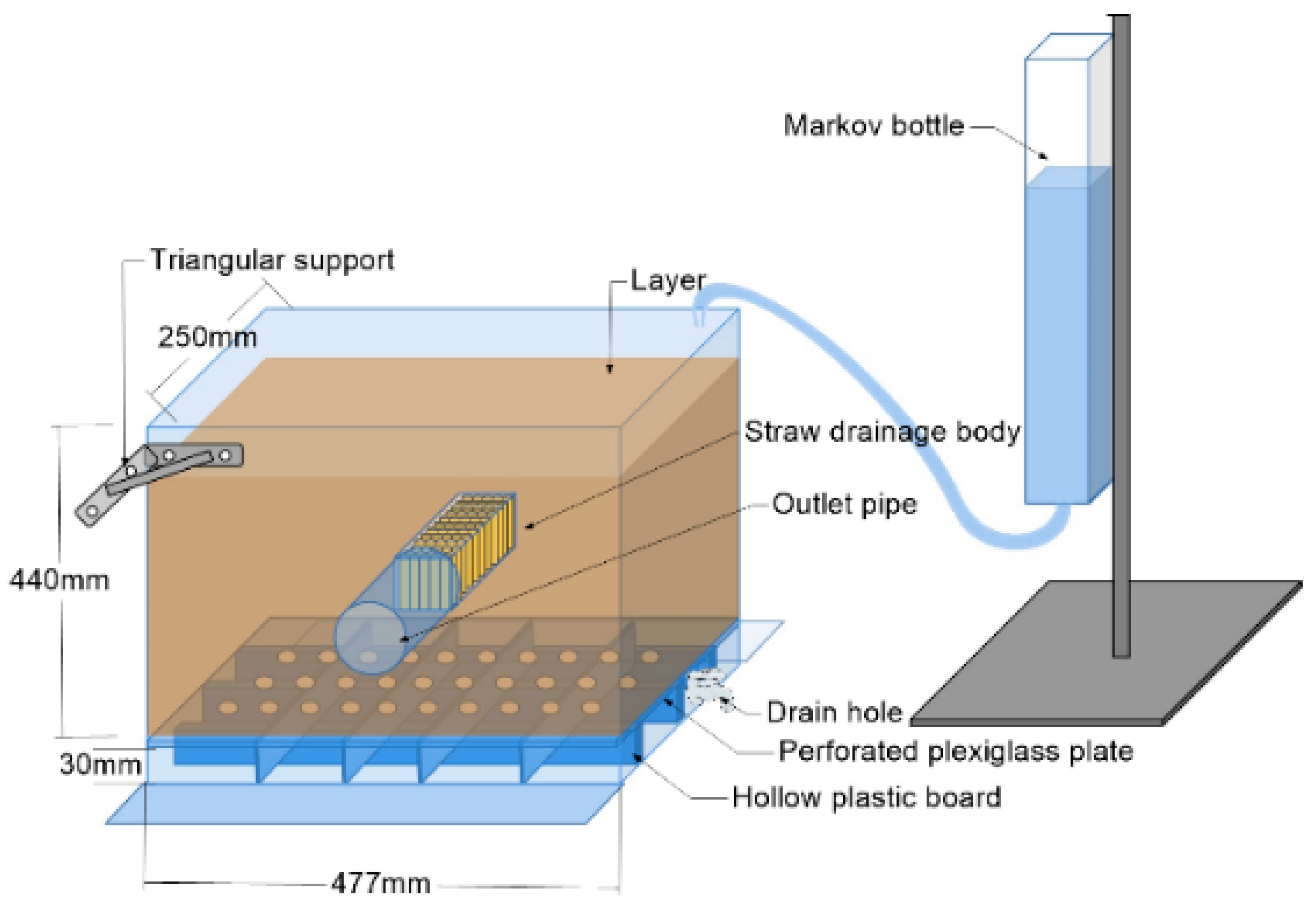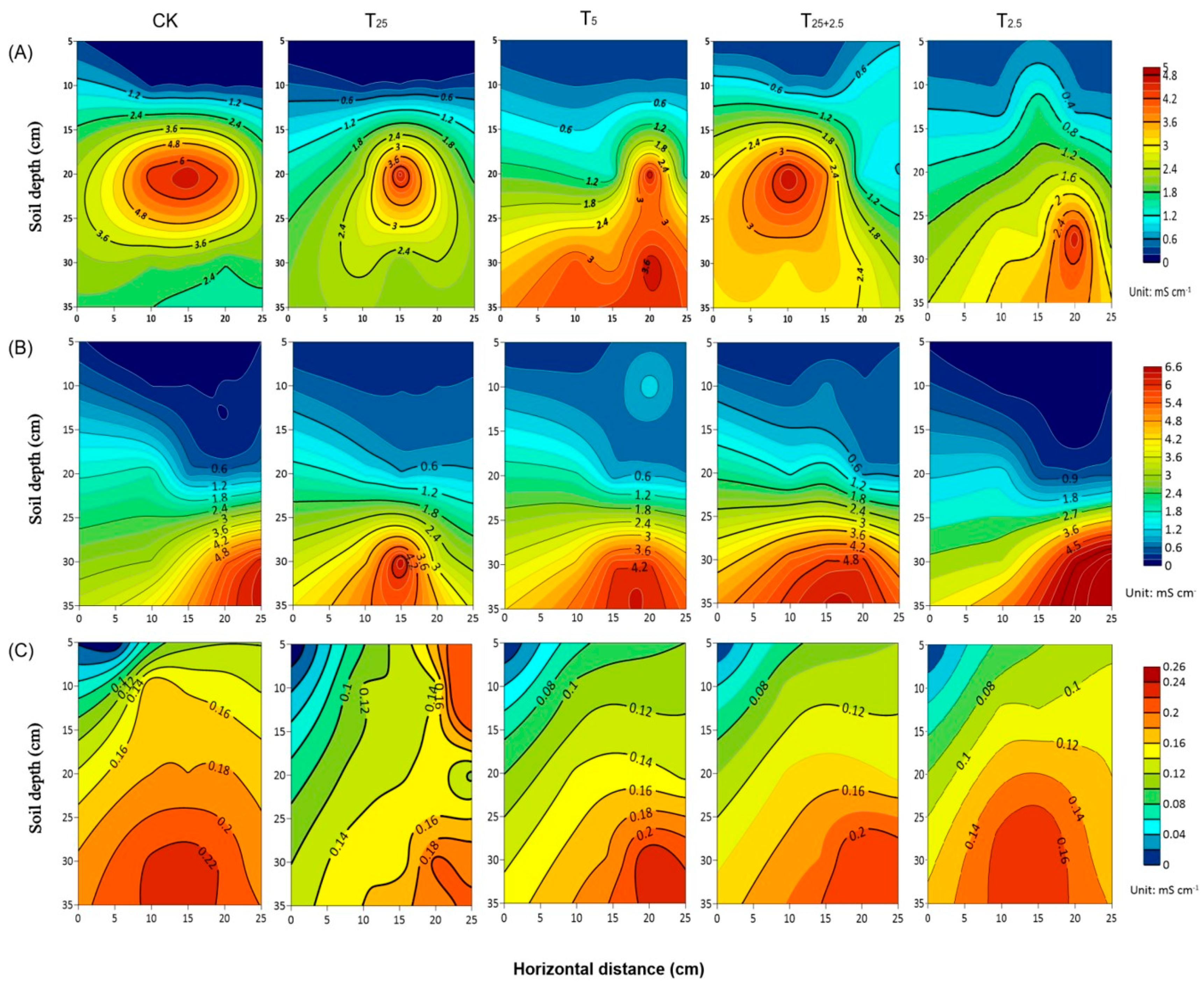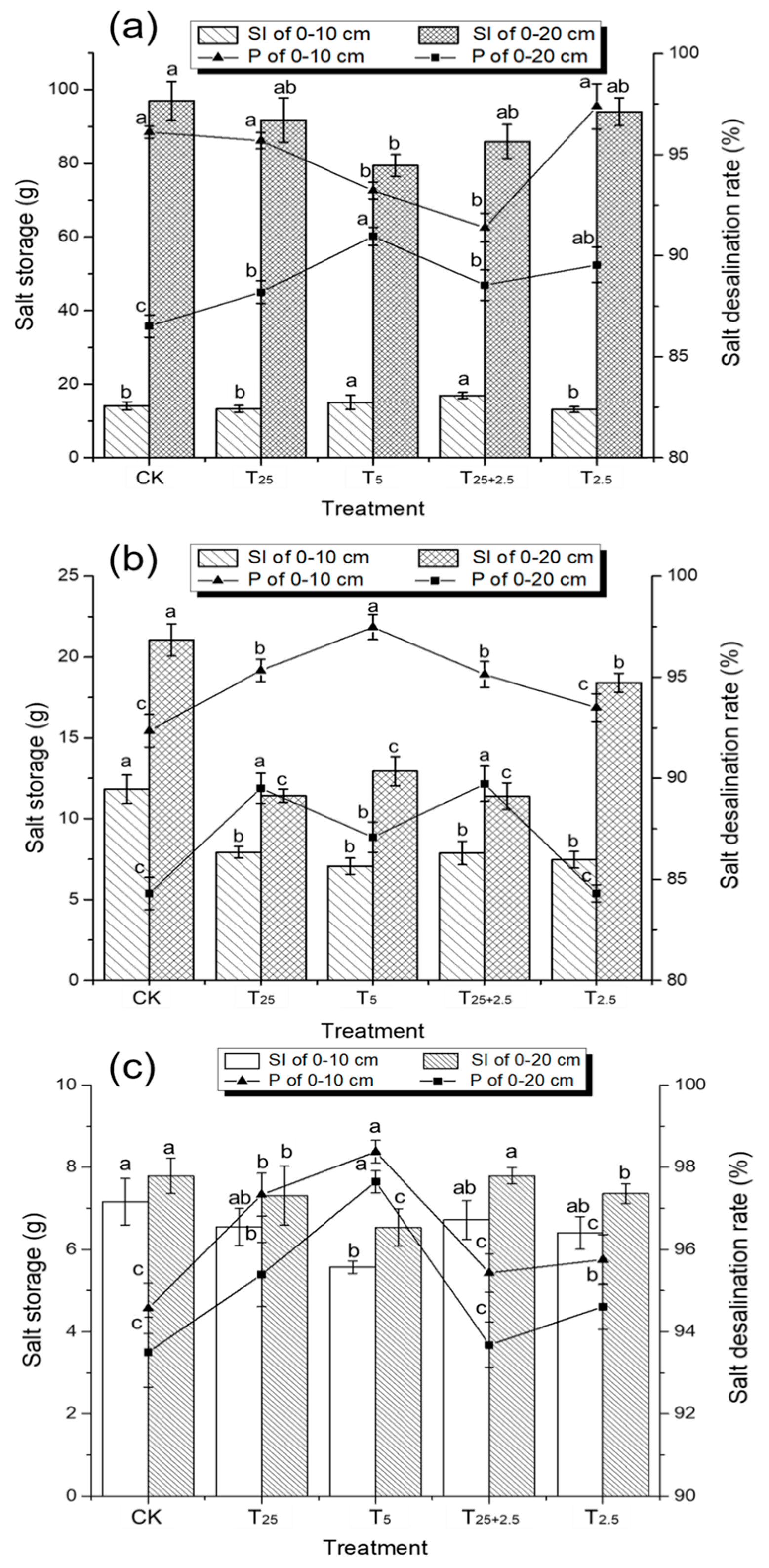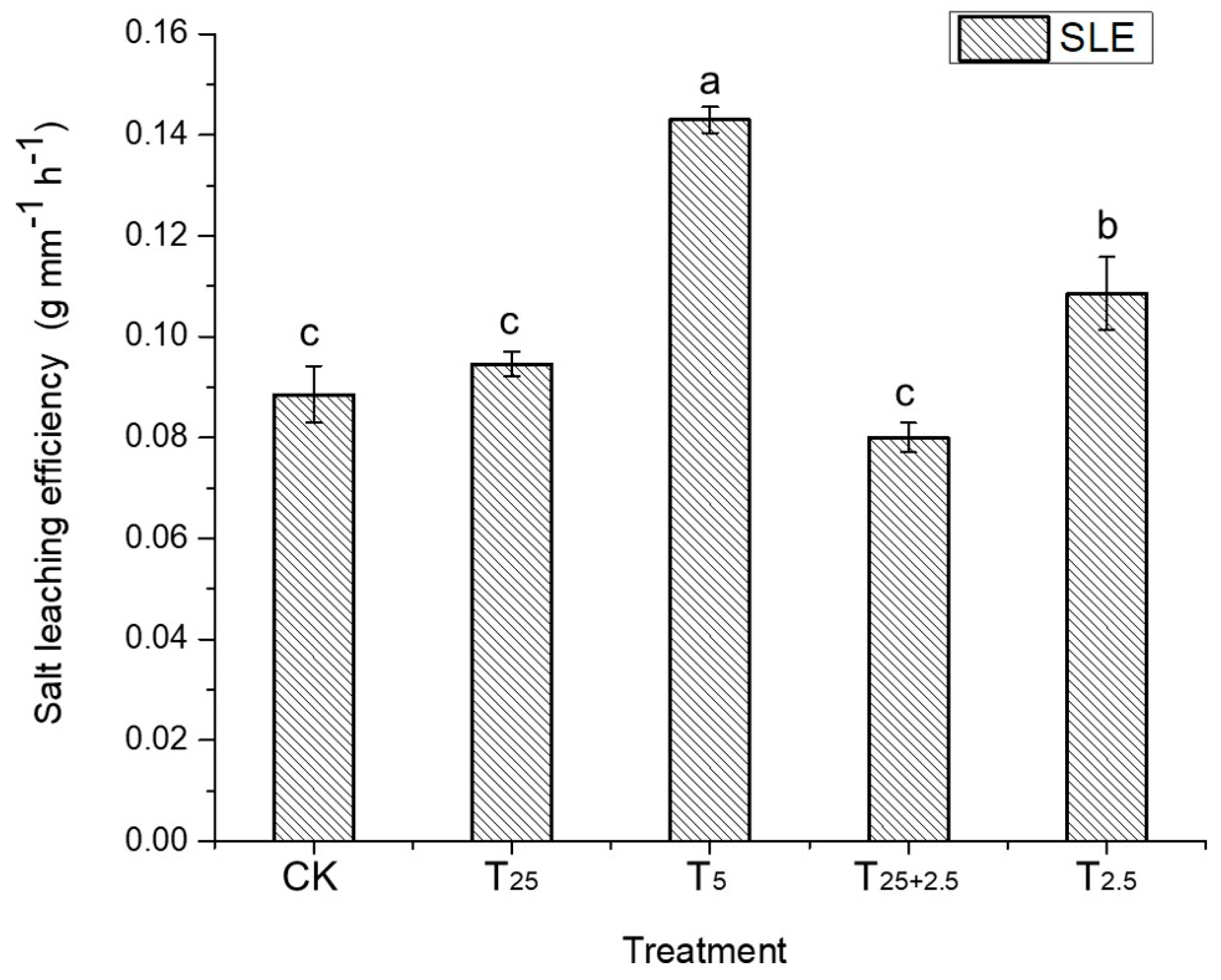Effects of Buried Straw Strips with Different Internal Structures on Water and Salt Distribution and Leaching Efficiency in Coastal Saline Soil
Abstract
:1. Introduction
- (1)
- To determine the effects of different forms of straw layer (or strips) treatments on water and salt distribution in the soil;
- (2)
- To investigate the leaching process and efficiency under different forms of straw strips;
- (3)
- To identify the appropriate form for straw strip treatments.
2. Materials and Methods
2.1. Experimental Site
2.2. Treatments
2.3. Experimental Process
2.3.1. Wetting Front
2.3.2. Irrigation Schedule
2.3.3. Soil Sampling Method
2.3.4. The Measurement of Soil Water Content and EC Value
2.4. Calculations
2.5. Data Analysis and Statistics
3. Results
3.1. Wetting Front
3.2. Water and Salt Distribution during and after the Infiltration
3.2.1. Water Distribution across the Soil Layer
3.2.2. Salt Distribution (EC1:5) across the Soil Layer
3.3. Analysis of Salt Desalination Rate and Leaching Efficiency under Different Treatments
4. Discussion
4.1. Wetting Front
4.2. Water and Salt Distribution
4.3. Salt Leaching Efficiency
5. Conclusions
- At the end of the experiment, the average water content (0–20 cm) under the straw layer (T2.5) was significantly higher than the CK treatment. Compared with CK, the salt content under straw strip treatments (T25, T5, and T25+2.5) and the straw layer (T2.5) were significantly lower in the 0–20 cm soil layer.
- Among the straw layer (or straw strip) treatments, the T5 and T2.5 treatments showed higher desalination rates and salt leaching efficiency in the 0–20 cm soil layer than T25 and T25+2.5 treatments.
- T5 treatment can be arranged more easily in actual production and showed a shorter infiltration time for irrigation water, as well as higher salt leaching efficiency in the 0–20 cm soil layer than the other straw treatments. Therefore, T5 is recommended as the optimal treatment compared to others.
Author Contributions
Funding
Institutional Review Board Statement
Data Availability Statement
Conflicts of Interest
References
- Alotaibi, M.M.; Aljuaid, A.; Alsudays, I.M.; Aloufi, A.S.; AlBalawi, A.N.; Alasmari, A.; Alghanem, S.M.S.; Albalawi, B.F.; Alwutayd, K.M.; Gharib, H.S.; et al. Effect of Bio-Fertilizer Application on Agronomic Traits, Yield, and Nutrient Uptake of Barley (Hordeum vulgare) in Saline Soil. Plants 2024, 13, 951. [Google Scholar] [CrossRef] [PubMed]
- Qi, J.; Sun, K.; Pan, Y.; Hu, Q.; Zhao, Y. Effect of Ridging Shapes on the Water–Salt Spatial Distribution of Coastal Saline Soil. Water 2023, 15, 2999. [Google Scholar] [CrossRef]
- Amerian, M.; Palangi, A.; Gohari, G.; Ntatsi, G. Enhancing salinity tolerance in cucumber through Selenium biofortification and grafting. BMC Plant Biol. 2024, 24, 24. [Google Scholar] [CrossRef] [PubMed]
- FAO. Global Map of Salt Affected Soils Version 1.0. 2021. Available online: https://www.fao.org/soils-portal/data-hub/soil-maps-and-databases/global-map-of-salt-affected-soils/en (accessed on 10 May 2024).
- Li, J.; Pu, L.; Han, M.; Zhu, M.; Zhang, R.; Xiang, Y. Soil salinization research in China: Advances and prospects. J. Geogr. Sci. 2014, 24, 943–960. [Google Scholar] [CrossRef]
- Guo, J.; Du, M.; Lu, C.; Wang, B. Use of Salt-Tolerant Plants and Halophytes as Potential Crops in Saline Soils in China. World J. Agric. Soil Sci. 2020, 5. [Google Scholar] [CrossRef]
- Zhou, J.; Miao, Y.; Guo, L.; Zhang, T.; Nie, Z.; Luo, X.; Yang, F.; Wang, Z. Evaluating the Enzyme Activities and Soil Physicochemical Properties of Four Typical Halophytic Communities in Saline-Sodic Soil. Agronomy 2024, 14, 141. [Google Scholar] [CrossRef]
- Chen, S.; Zhang, Z.; Wang, Z.; Guo, X.; Liu, M.; Hamoud, Y.A.; Zheng, J.; Qiu, R. Effects of uneven vertical distribution of soil salinity under a buried straw layer on the growth, fruit yield, and fruit quality of tomato plants. Sci. Hortic. 2016, 203, 131–142. [Google Scholar] [CrossRef]
- Wang, J.; Huang, X.; Zhong, T.; Chen, Z. Climate change impacts and adaptation for saline agriculture in north Jiangsu Province, China. Environ. Sci. Policy 2013, 25, 83–93. [Google Scholar] [CrossRef]
- Nan, J.; Chen, X.; Wang, X.; Lashari, M.S.; Wang, Y.; Guo, Z.; Du, Z. Effects of applying flue gas desulfurization gypsum and humic acid on soil physicochemical properties and rapeseed yield of a saline-sodic cropland in the eastern coastal area of China. J. Soils Sediments 2016, 16, 38–50. [Google Scholar] [CrossRef]
- Lu, P.; Zhang, Z.; Sheng, Z.; Huang, M.; Zhang, Z. Effect of surface straw incorporation rate on water–salt balance and maize yield in soil subject to secondary salinization with brackish water irrigation. Agronomy 2019, 9, 341. [Google Scholar] [CrossRef]
- Sun, Y.P.; Yang, J.S.; Yao, R.J.; Chen, X.B.; Wang, X.P. Biochar and fulvic acid amendments mitigate negative effects of coastal saline soil and improve crop yields in a three year field trial. Sci. Rep. 2020, 10, 8946. [Google Scholar] [CrossRef]
- Song, X.; Sun, R.; Chen, W.; Wang, M. Effects of surface straw mulching and buried straw layer on soil water content and salinity dynamics in saline soils. Can. J. Soil Sci. 2020, 100, 58–68. [Google Scholar] [CrossRef]
- Du, C.; Li, L.; Effah, Z. Effects of Straw Mulching and Reduced Tillage on Crop Production and Environment: A Review. Water 2022, 14, 2471. [Google Scholar] [CrossRef]
- Li, M.; Wang, W.; Wang, X.; Yao, C.; Wang, Y.; Wang, Z.; Zhou, W.; Chen, E.; Chen, W. Effect of Straw Mulching and Deep Burial Mode on Water and Salt Transport Regularity in Saline Soils. Water 2023, 15, 3227. [Google Scholar] [CrossRef]
- Wang, X.; Jia, Z.; Liang, L.; Zhao, Y.; Yang, B.; Ding, R.; Wang, J.; Nie, J. Changes in soil characteristics and maize yield under straw returning system in dryland farming. Field Crops Res. 2018, 218, 11–17. [Google Scholar] [CrossRef]
- Sarker, K.K.; Kamar, S.S.A.; Hossain, M.A.; Mainuddin, M.; Bell, R.W.; Barrett-Lennard, E.G.; Gaydon, D.; Glover, M.; Saha, R.R.; Rashid, M.H.; et al. Effect of Straw Mulch and Irrigation on Sunflower and Maize Cultivation in No Tillage Systems of Coastal Heavy Soils. Proceedings 2019, 36, 145. [Google Scholar] [CrossRef]
- Zhao, Y.; Li, Y.; Wang, J.; Pang, H.; Li, Y. Buried straw layer plus plastic mulching reduces soil salinity and increases sunflower yield in saline soils. Soil Tillage Res. 2016, 155, 363–370. [Google Scholar] [CrossRef]
- Huo, L.; Pang, H.; Zhao, Y.; Wang, J.; Lu, C.; Li, Y. Buried straw layer plus plastic mulching improves soil organic carbon fractions in an arid saline soil from Northwest China. Soil Tillage Res. 2017, 165, 286–293. [Google Scholar] [CrossRef]
- Cao, J.; Liu, C.; Zhang, W.; Guo, Y. Effect of integrating straw into agricultural soils on soil infiltration and evaporation. Water Sci. Technol. 2012, 65, 2213–2218. [Google Scholar] [CrossRef]
- Zhao, Y.; Li, Y.; Hu, X.; Wang, J.; Pang, H. Effects of plastic mulching and deep burial of straw on dynamics of soil water and salt in micro-plot field cultivation. Acta Pedol. Sin. 2013, 50, 1129–1137. [Google Scholar] [CrossRef]
- Zhang, J.X. Study on the Effect of Straw Mulching on Farmland Soil Water. J. Environ. Public Health 2022, 2022, 3101880. [Google Scholar] [CrossRef] [PubMed]
- Chang, L.; Han, F.; Han, F.; Chai, S.; Cheng, H.; Yang, D.; Chen, Y. Straw strip mulching affects soil moisture and temperature for potato yield in semiarid regions. Agron. J. 2019, 112, 1126–1139. [Google Scholar] [CrossRef]
- Chai, Y.; Chai, Q.; Li, R.; Li, Y.; Yang, C.; Cheng, H.; Chang, L.; Chai, S. Straw strip mulching in a semiarid rainfed agroecosystem achieves winter wheat yields similar to those of full plastic mulching by optimizing the soil hydrothermal regime. Crop J. 2022, 10, 879–892. [Google Scholar] [CrossRef]
- Huang, C.; Wu, Y.; Ye, Y.; Li, Y.; Ma, J.; Ma, J.; Yan, J.; Chang, L.; Wang, Z.; Wang, Y.; et al. Straw Strip Mulching Increases Winter Wheat Yield by Optimizing Water Consumption Characteristics in a Semi-Arid Environment. Water 2022, 14, 1894. [Google Scholar] [CrossRef]
- Chen, Y.; Chai, S.; Tian, H.; Chai, Y.; Li, Y.; Chang, L.; Cheng, H. Straw strips mulch on furrows improves water use efficiency and yield of potato in a rainfed semiarid area. Agric. Water Manag. 2019, 211, 142–151. [Google Scholar] [CrossRef]
- Lan, X.; Chai, S.; Coulter, J.A.; Cheng, H.; Chang, L.; Huang, C.; Li, R.; Chai, Y.; Li, Y.; Ma, J.; et al. Maize straw strip mulching as a replacement for plastic film mulching in maize production in a semiarid region. Sustainability 2020, 12, 6273. [Google Scholar] [CrossRef]
- Lu, P.; Zhang, Z.; Sheng, Z.; Huang, M.; Zhang, Z. Assess effectiveness of salt removal by a subsurface drainage with bundled crop straws in coastal saline soil using HYDRUS-3D. Water 2019, 11, 943. [Google Scholar] [CrossRef]
- Pansu, M.; Gautheyrou, J. Water Content and Loss on Ignition, Handbook of Soil Analysis. Mineralogical, Organic and 470 Inorganic Methods; Springer: Berlin/Heidelberg, Germany, 2006; pp. 3–13. [Google Scholar] [CrossRef]
- Dane, J.H.; Topp, G.C. (Eds.) Methods of Soil Analysis, Part 4-Physical 494 Methods; Soil Science Society of America: Madison, WI, USA, 2002; pp. 417–545. [Google Scholar] [CrossRef]
- United States Department of Agriculture (USDA). Diagnoses and Improvement of Saline and Alkali Soils; Agriculture Handbook No. 60; United States Department of Agriculture: Washington, DC, USA, 1954. Available online: https://acsess.onlinelibrary.wiley.com/doi/abs/10.2136/sssaj1954.03615995001800030032x (accessed on 10 May 2024).
- He, Y.; DeSutter, T.; Prunty, L.; Hopkins, D.; Jia, X.; Wysocki, D. Evaluation of 1:5 soil to water extract electrical conductivity methods. Geoderma 2012, 185–186, 12–17. [Google Scholar] [CrossRef]
- Jiang, S.Q.; Yu, Y.N.; Gao, R.W.; Wang, H.; Zhang, J.; Li, R.; Long, X.H.; Shen, Q.R.; Chen, W.; Cai, F. High-throughput absolute quantification sequencing reveals the effect of different fertilizer applications on bacterial community in a tomato cultivated coastal saline soil. Sci. Total Environ. 2019, 687, 601–609. [Google Scholar] [CrossRef]
- Ashkan, Y.; Ahmad, F.; Milad, A. The effects of shallow saline groundwater on evaporation, soil moisture, and temperature distribution in the presence of straw mulch. Hydrol. Res. 2020, 51, 720–738. [Google Scholar] [CrossRef]
- Rahma, A.E.; Wang, W.; Tang, Z.; Lei, T.; Warrington, D.N.; Zhao, J. Straw mulch can induce greater soil losses from loess slopes than no mulch under extreme rainfall conditions. Agric. For. Meteorol. 2017, 232, 141–151. [Google Scholar] [CrossRef]
- Li, Y.; Pang, H.; Han, F.; Yan, S.; Zhao, Y.; Wang, J.; Zhai, Z.; Zhang, J. Buried straw layer and plastic mulching increase microflora diversity in salinized soil. J. Integr. Agric. 2016, 15, 1602–1611. [Google Scholar] [CrossRef]
- Meyer, M.; Diehl, D.; Schaumann, G.E.; Muñoz, K. Multiannual soil mulching in agriculture: Analysis of biogeochemical soil processes under plastic and straw mulches in a 3-year field study in strawberry cultivation. J. Soils Sediments 2021, 21, 3733–3752. [Google Scholar] [CrossRef]
- Li, Y.; Chai, Y.; Ma, J.; Li, R.; Cheng, H.; Chang, L.; Chai, S. Straw strip mulching in a semiarid rainfed agroecosystem achieves carbon sequestration and emission reduction from winter wheat fields. Agric. Ecosyst. Environ. 2022, 334, 107990. [Google Scholar] [CrossRef]
- Zhang, H.; Lu, C.; Pang, H.; Liu, N.; Zhang, X.; Li, Y. Straw layer burial to alleviate salt stress in silty loam soils: Impacts of straw forms. J. Integr. Agric. 2020, 19, 265–276. [Google Scholar] [CrossRef]
- Li, X.; Chang, S.X.; Salifu, K.F. Soil texture and layering effects on water and salt dynamics in the presence of a water table: A review. Environ. Rev. 2013, 22, 41–50. [Google Scholar] [CrossRef]
- Zhang, H.; Pang, H.; Zhao, Y.; Lu, C.; Liu, N.; Zhang, X.; Li, Y. Water and salt exchange flux and mechanism in a dry saline soil amended with buried straw of varying thicknesses. Geoderma 2020, 365, 114213. [Google Scholar] [CrossRef]
- Meng, X.; Gao, M.; Ma, T.; Yan, L. Analysis of Pore Structure on Carbon Powder of Hemp Straw. Adv. Mater. Res. 2010, 177, 640–642. [Google Scholar] [CrossRef]
- Zheng, J.; Wang, Y.; Cai, H.; Zhang, E.; Sun, Y. Experimental investigation into effects of maize leaf and straw fragments on soil water infiltration characteristics in furrow irrigation. J. Drain. Irrig. Mach. Eng. 2016, 34, 66–78. [Google Scholar] [CrossRef]
- Yang, H.; Rahardjo, H.; Leong, E.C.; Fredlund, D.G. A study of infiltration on three sand capillary barriers. Can. Geotech. J. 2004, 41, 629–643. [Google Scholar] [CrossRef]
- Paul, P.L.C.; Bell, R.W.; Barrett-Lennard, E.G.; Kabir, E. Impact of Rice Straw Mulch on Soil Physical Properties, Sunflower Root Distribution and Yield in a Salt-Affected Clay-Textured Soil. Agriculture 2021, 11, 264. [Google Scholar] [CrossRef]
- Xu, Q.; Liu, H.; Li, M.; Li, P. The Presence of the Biochar Interlayer Effectively Inhibits Soil Water Evaporation and Salt Migration to the Soil Surface. Agriculture 2023, 13, 638. [Google Scholar] [CrossRef]
- Abd El-Wahed, M.H.; Al-Omran, A.M.; Hegazi, M.M.; Ali, M.M.; Ibrahim, Y.A.M.; EL Sabagh, A. Salt Distribution and Potato Response to Irrigation Regimes under Varying Mulching Materials. Plants 2020, 9, 701. [Google Scholar] [CrossRef] [PubMed]
- Szoboszlay, M.; Näther, A.; Liu, B.; Carrillo, A.; Castellanos, T.; Smalla, K.; Jia, Z.; Tebbe, C.C. Contrasting microbial community responses to salinization and straw amendment in a semiarid bare soil and its wheat rhizosphere. Sci. Rep. 2019, 9, 9795. [Google Scholar] [CrossRef]
- Burt, C.M.; Isabell, B. Leaching of accumulated soil salinity under drip irrigation. Am. Soc. Agric. Eng. 2005, 48, 2115–2121. [Google Scholar] [CrossRef]
- Monteleone, M. Irrigation management in Mediterranean salt affected agriculture: How leaching operates. Ital. J. Agron. 2012, 7, e5. [Google Scholar] [CrossRef]
- Su, X.; Wang, Y.; Wang, G.; Zhang, Y.; Gong, X.; Yu, J.; Gou, F.; Lu, H. Assessment and prediction of coastal saline soil improvement effects combining substrate amendments and salt barrier materials in typical region of the Yangtze River Delta. Soil Tillage Res. 2022, 223, 105483. [Google Scholar] [CrossRef]








| Treatment 1 | Time for Wetting Front to Transit from 5 cm to 20 cm in Depth from the Top of the Soil (h) | Time for Wetting Front to Transit from 20 cm to 25 cm in Depth from the Top of the Soil (h) | Time for Wetting Front to Transit from 25 cm to 35 cm in Depth from the Top of the Soil (h) |
|---|---|---|---|
| CK | 24.06 ± 0.11 b | 3.16 ± 0.03 c | 24.43 ± 0.02 c |
| T25 | 24.12 ± 0.02 b | 5.13 ± 0.11 b | 26.38 ± 0.04 b |
| T5 | 24.05 ± 0.03 b | 5.05 ± 0.02 b | 26.57 ± 0.05 b |
| T25+2.5 | 24.17 ± 0.05 b | 5.34 ± 0.03 b | 26.36 ± 0.02 b |
| T2.5 | 25.55 ± 0.03 a | 6.57 ± 0.04 a | 29.17 ± 0.08 a |
Disclaimer/Publisher’s Note: The statements, opinions and data contained in all publications are solely those of the individual author(s) and contributor(s) and not of MDPI and/or the editor(s). MDPI and/or the editor(s) disclaim responsibility for any injury to people or property resulting from any ideas, methods, instructions or products referred to in the content. |
© 2024 by the authors. Licensee MDPI, Basel, Switzerland. This article is an open access article distributed under the terms and conditions of the Creative Commons Attribution (CC BY) license (https://creativecommons.org/licenses/by/4.0/).
Share and Cite
Masharifov, U.; Wang, Z.; Li, Q.; Wang, Y.; Tian, M.; Qiang, X.; Liu, J.; Wang, Y.; Fan, Y.; Chen, K.; et al. Effects of Buried Straw Strips with Different Internal Structures on Water and Salt Distribution and Leaching Efficiency in Coastal Saline Soil. Agriculture 2024, 14, 994. https://doi.org/10.3390/agriculture14070994
Masharifov U, Wang Z, Li Q, Wang Y, Tian M, Qiang X, Liu J, Wang Y, Fan Y, Chen K, et al. Effects of Buried Straw Strips with Different Internal Structures on Water and Salt Distribution and Leaching Efficiency in Coastal Saline Soil. Agriculture. 2024; 14(7):994. https://doi.org/10.3390/agriculture14070994
Chicago/Turabian StyleMasharifov, Umidbek, Zhenchang Wang, Qingxin Li, Yaosheng Wang, Minghao Tian, Xiaoman Qiang, Jinjing Liu, Yuexiong Wang, Yanwei Fan, Kexin Chen, and et al. 2024. "Effects of Buried Straw Strips with Different Internal Structures on Water and Salt Distribution and Leaching Efficiency in Coastal Saline Soil" Agriculture 14, no. 7: 994. https://doi.org/10.3390/agriculture14070994





